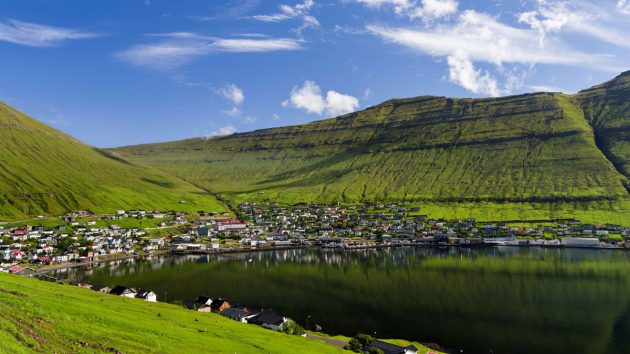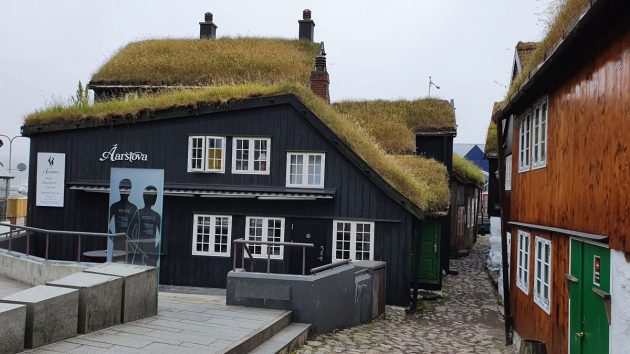Lying halfway between Scotland and Iceland, the Faroe Islands offer an abundance of nature, culture and challenging sailing
Never has the welcome been more warm and friendly than on the Faroe Islands, writes Joanna Krasuska.
Over the last three years we have spent four months cruising this Danish archipelago, which lies around 180 miles northwest of the Shetland Islands in the North Atlantic.
My advice is to go with the flow and let the friendliness of the Faroese people engulf you.
Many will simply arrive at your boat armed with smiles and open hearts as they greet you as a fellow seafarer, wanting to know about your voyage to their shores.
The Faroe Islands consists of 18 major islands and a further 779 smaller islands, islets, and skerries.

Currents are strong so ensure you plan passages around the Faroe Islands carefully. Credit: Joanna Krasuska
As they hove into view, you are almost overwhelmed by the spectacularly rocky but green landscape consisting mainly of grasslands, which provide ample grazing grounds for sheep.
The terrain is rugged, with the weather being ruled by the sub-polar oceanic climate resulting in lots of wind, high humidity, and a fair share of cloudy days.
The temperatures are moderated by the Gulf Stream and rarely drop below zero, even in the winter, averaging around 12°C in summer and 5°C in winter.
Thanks to the geographical location, summer nights offer perpetual twilight, while the winter days are very short.
Sailing around the archipelago of the Faroe Islands can be tricky. The topography of the islands disrupts the flow of wind significantly meaning that you do have to work hard for your sailing fix.

Fuglafjørður is one of six ports of entry in the Faroe Islands. Credit: Getty
Katabatic winds feature regularly so it is wise to put a reef in even if the forecast suggests otherwise.
The capital, Tórshavn, is home to 13,000 of the 50,000 people who live on these islands. The harbour is very well protected, has water and power on the pontoons, a laundry and hot showers.
The beautiful houses around the port are the oldest part of the city. Walking through the narrow streets, you get a real sense that very little has changed
here in the last 100 years.
There are lots of cafés, restaurants and even an Irish pub. Next to the harbour is the main shipyard and this is the place to get repairs, should they be needed, although if you are sailing this far north a good stock of spares onboard is highly advised.

Credit: Maxine Heath
On a sunny day, walk from Tórshavn to Kirkjubøur, a Faroese village with a gorgeous restored period property, which you are free to look around.
At the edge of the village are ruins of the Magnus Cathedral, which used to serve as an episcopal residence until its abolishment in 1557.
The walk takes about three hours; it is not very hard but a good pair of walking shoes is required. Be prepared for some truly spectacular views along the way.
There is also a free local bus service to the village.
For an on-land tour, it is worth heading to Saksun, a little village famous for its unique location above a lagoon, surrounded by steep mountains and a multitude of waterfalls.
The lagoon used to provide a natural harbour until it was blocked by a landslide during a heavy storm in 1600.
Island hopping
The island of Nólsoy is located just three miles to the west of Tórshavn. It is the lowest of the Faroe Islands, with the highest point Eggjaklettur, reaching 372m.
A scenic hike leads to the south end with two capes, each with a lighthouse.
Nólsoy makes a great second stop after checking in to Tórshavn, and gives a real taste of the lovely small communities that abound here.

The Faroe Islands lie in the North Atlantic. Credit: Maxine Heath
The currents around the islands are strong and we found the RAK tidal app was essential.
It is best to sail the short distance from the capital to Nólsoy at slack tide. The harbour is very well protected, and there is a charge for electricity but not for mooring here.
There is a shop, a small bar at the dockside, operating from someone’s living room, and a pub called Maggie’s Café with great food, drink, music and atmosphere.
Continues below…
Sailing the Baltic Sea: where to go
Is the Baltic the new Mediterranean? Rachael Sprot takes a closer look at this underrated cruising ground
Sailing Scotland: the best routes
Whether you’ve just got a few days to explore the West Coast, or the open North Atlantic is calling, Scotland’s…
La Gomera: a sail on the wild side
Dr Lou Luddington explores La Gomera’s rugged coast and discovers abundant wildlife while freediving from her yacht
How to sail to France from the UK
For home-waters sailors who are considering a holiday cruise to France, Ken Endean looks at the options for making a…
Fuglafjørður, on the island of Eysturoy, offers a very well protected and free visitor’s pontoon.
Although there is no electric hook-up on the pontoon, with a long enough cable it is possible to plug in to the nearby facilities.
In the town you’ll find a local craft and coffee shop, Ribarhús, offering cultural and music events, beautiful woollen clothes, decorations and other handcrafted goods, all made locally.

The largest harbour is in the capital, Tórshavn. Credit: Getty
Many Faroese towns are situated on mountainsides surrounding a fjord, and Fuglafjørður on the east coast of Eysturoy is no exception.
With all of its colourful houses, many with grass roofs, this town is beautiful.
There are a number of walks leading up the mountainside, all with spectacular views.
On the north coast are the most well known sea stacks in the archipelago, the Giant and the Witch.
The nearby town of Eiði has a large harbour, and is one of the best places to watch the sun set.

The sea stacks of the Giant and the Witch are located off Eysturoy. Credit: Joanna Krasuska
For those craving a peaceful retreat, Hestur has a small harbour protected by a very substantial wall and offers a couple of pontoons with power and water.
There are only 37 people living on the island and there isn’t a shop so provision before arriving.
Hiking trails are marked with wooden stakes and lead up to the uniquely flat top of this tall island, where you will find many freshwater lakes.
It’s a moderate 45-minute hike up the grassy hill.
There is also an old settlement from Viking times on the southern tip of the island, called Hælur.
The tranquillity of this place attracts nesting eider ducks, which sit in a hibernation-like state on their eggs for a period of 30 days continuously, right in the harbour.

Knitting is a national hobby in the Faroe Islands and homemade jumpers can be bought on most islands. Credit: Joanna Krasuska
On the west side of Hestur there are a number of caves. Some of them are huge and have such good acoustics that the locals organise concerts inside.
It is only possible to enter these caves by dinghy; visits must be made in calm conditions.
You can take an organised tour but if you prefer your own steam then one person will have to remain onboard as it is too deep to anchor outside of the caves.
Wherever and however you choose to visit these beautiful islands, be prepared to be seduced by their rugged natural beauty and by the lovely locals.
A visit to the Faroe Islands may just change you forever.
Tips for sailing in the Faroe Islands
It is best to visit the Faroe Islands during the summer months, when the days are longer and weather is kinder.
There are six port of entries: Tórshavn, Fuglafjørður, Klaksvík, Vágur, Tvøroyri and Vestmanna.
The RAK tide app is essential as the currents around the Faroe Islands can, at times, be described as extremely dangerous.
However, this statement should not put anyone off from visiting these wonderful islands because with the aid of this easy to use app, fast and safe passage around the islands can be made.
The app is available for both iPhone and Android and can be downloaded from iTunes and Play store respectively or from the website www.rak.fo

Traditional house in Tórshavn with grass roofs, which was a traditional form of insulation. Credit: Joanna Krasuska
Whatever the sailing challenges are, the joy and exhilaration of sailing up close to the sheer cliffs protruding from the water and towering above your mast is something very special.
There is a pump-out station in Argir just south of Tórshavn, the capital city, although there are no requirements for the fitting of holding tanks.
Electricity is available in most harbours. Electricity cards can be purchased using credit cards at dedicated machines.

Joanna Krasuska and her partner, Mark Thompson, live aboard their Moody 44, Altor of Down. They have spent the last three years cruising the north Atlantic, exploring England, Scotland, Wales, the Faroe Islands, Iceland and this year, Norway and Svalbard. They document their adventures on their You Tube channel, Adventure Now and at www.adventure-now.org. Their plan for the coming season is to carry on cruising the northern latitudes. Credit: Joanna Krasuska
Both the electricity supply and the sockets are compatible with European standards (AC 220 volts, 50 cycles). An extra long connection cable can be invaluable!
Diesel is available in most harbours but a special card is required to operate the pumps, except in Tórshavn and Klaksvík.
Propane gas is available but the connections are not suitable for UK regulators so we always ensure we have enough gas for our entire trip.
However, Faroese propane gas cylinders and regulators can be bought in the bigger towns.
Pilot guides and charts for cruising the Faroe Islands
Buy Arctic and Northern Waters by Andrew Wilkes at Amazon (UK)
Buy Arctic and Northern Waters by Andrew Wilkes at Amazon (US)
Buy Arctic and Northern Waters by Andrew Wilkes at Waterstones (UK)
Buy Arctic and Northern Waters by Andrew Wilkes at Google Play
Cruising Guide to Iceland, the Faroe Islands, Greenland and Jan Mayen 2022 by Michael Henderson and Helen Gould, (Cruising Association, £31), available free to CA members. www.theca.org.uk
Geodatastyrelsen 80, 81, 82, 83, 84, 85, 86
Note: We may earn a commission when you buy through links on our site, at no extra cost to you. This doesn’t affect our editorial independence.
Enjoyed reading this article?
A subscription to Yachting Monthly magazine costs around 40% less than the cover price.
Print and digital editions are available through Magazines Direct – where you can also find the latest deals.
YM is packed with information to help you get the most from your time on the water.
-
-
-
- Take your seamanship to the next level with tips, advice and skills from our experts
- Impartial in-depth reviews of the latest yachts and equipment
- Cruising guides to help you reach those dream destinations
-
-
Follow us on Facebook, Twitter and Instagram.








